The 1907 Mondragon was one of the first semiautomatic rifles formally adopted by a national military. It was designed by Mexican Manuel Mondragon, beginning in 1891. Its development was encouraged by future Mexican President Porfirio Diaz, who was very interested in military arms and eager for the prestige of Mexico being the first nation to field a semiautomatic shoulder rifle.
Development
The first Mondragon rifles were bolt actions produced in 1893, chambered for 6.5mm Mondragon. Production of the rifle was outsourced to the Swiss firm SIG in Neuhausen, which delivered 50 units for testing by the Mexican army. The trials were successful enough to warrant an order for 200 more rifles in 1894, in a theoretically better 5.2 x 68mm cartridge. This was developed by Mondragon in collaboration with the Swiss Colonel Rubin (of Schmidt-Rubin rifle notability), and was a very high pressure round. Too high pressure to work well, as it turned out.
Later variants of the Mondragon returned to more conventional cartridges, with a 1903 model being submitted to British army testing chambered for 7mm Mauser. Rifles were also produced in 7.5mm Swiss and .30-30 Winchester.
The main contract for the Mexican Army was placed in 1908, for 4,000 rifles in 7mm Mauser. Some of these, in an effort to ingratiate President Diaz, were marked “Fusil Porfirio Diaz, Systema Mondragon, Model 1908”. The first 400 were delivered in 1911, and it was found (as had been warned by SIG officials) that the guns had very little tolerance for poor quality ammunition. Much to SIG’s dismay, the Mexican government decided to cancel the order after only 1,000 had been delivered, leaving SIG with 3,000 finicky rifles not paid for.
Once the First World War broke out, demand for military arms was predictably great, and SIG found a buyer for the Mondragon rifles in the German air corps. It was adopted as the Flieger-Selbstlader-Karabiner 15 (Self-Loading Aircraft Carbine, Model 1915) as a stopgap measure to give aerial observers a firearm that could be effectively used in flight. For this use, the guns were equipped with a 30-round snail drum type magazine. Significant maintenance was required to keep the rifles operational, and accuracy was reportedly poor. They were subsequently replaced by the more accurate but even less reliable Mauser Selbstlader 1916.
The Mondragon was not a major part of any armed conflict, but remains a landmark weapon for being the first of its kind effective enough to be used in quantity by a national military.
Function and Mechanism
The Mondragon is a gas-operated rifle, with a gas port about three quarters of the way down the barrel. The bolt is of the rotating type, turned by two helical camming slots on the bolt body. There are three locking lugs on the front of the bolt and four more on the rear.
One unusual feature of the Mondragon is a cutoff switch on the bolt handle which allows the shooter to disengage the bolt from the gas piston. This, like the magazine cutoffs present on many early magazine rifles, was a feature desired by many military authorities to prevent soldiers from wasting ammunition through rapid fire. The notion was that the guns would be operated as manual straight-pull actions during normal use, and only switched to semiautomatic mode in emergencies.
Upon firing, gas engages the gas piston below the barrel pushing it back and compressing the mainspring. Instead of being directly connected to the bolt, the gas piston ends with a stub which acts on the bolt handle (which can be disengaged to render the gun manually operated). The bolt handle has lugs which engage the helical cams in the bolt body, so when retracted by the shooter of the gas system, it rotates and unlocks the bolt. In an effort seal gasses out of the receiver, the gas piston is fitted with a series of split rings.
As described in the patent below, the 1904/1907 version of the rifle is designed to use a 6-round enbloc clip. This clip could be latched in at two different depths in the magazine housing – pushed all the way in, the clip would below the line of bolt travel and held in reserve like a magazine cutoff. A latch behind at the back of the magazine housing would release the clip upwards to where rounds would be stripped off by the bolt, allowing semiautomatic fire. We believe this feature was removed at some point, as the clip latch is not present on most Mondragon rifles we have seen. Some variants were made to use 20-round box magazines, in addition to the German 30-round drum. The rifle used a leaf sight marked from 300-2000 yards, and it was issued with a spade-type bayonet.
Videos
This Mondragon was sold at auction by Rock Island Auction Co. in December 2014:
https://www.youtube.com/watch?v=GhCk6CI1R_c
Photos
Download this gallery in high resolution
Photos of a Mondragon M1908 in 7x57mm Mauser. This rifle is missing its magazine floorplate and spring assembly. Click here to download the gallery in high resolution.
Photos of a 20-round Mondragon magazine for 7x57mm Mauser. Click here to download the gallery in high resolution.
Patents
US Patent 853,715 (M. Mondragon, Firearm, May 14, 1907)



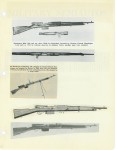
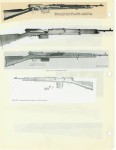
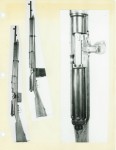
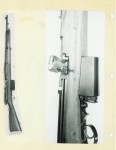
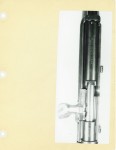
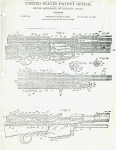
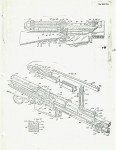
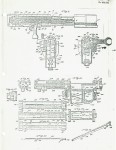
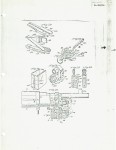
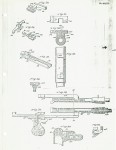













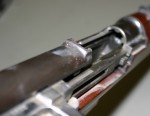


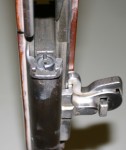
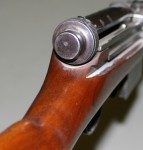
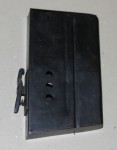

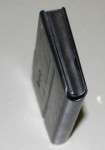

A fascinating piece.
Hope to see this on video at the range!
Nice to see more info on this rifle. I happen to be in possession of a 5.2mm version of this rifle with the en-bloc clip acquired by my father in the late 50s from MB Retting. Serial #1. Apparently it was originally bought from the Mondragon family by Retting.
I am a collector of Mondragon serial numbers, can you tell me the caliber and serial number of the above rifle. Do you know the meaning of the 3 digit number on the LH side of the stock in front of the magazine? The numbers are 81.4, 81.5 etc.
Sorry, Victor, but I’m not sure what the serial number was on this one. However, it will be showing up at auction in the next year or two. My guess on the magazine would be a rack number, but I can’t give you any direct evidence for that.
do yuou can sell me repeated
mondragon
for anyone interested, patent of the spade bayonet http://www.google.com/patents/US1003119
Upon closer examination of the extended magazine, I believe it to be of Swiss origin and made for the 7.5 x 55 round and part of the Swiss trials for the Mondragon.
Nice pictures of the Mondragon Rifle. You can see the original No. 1 rifle presented to General Porfirio Diaz in the Museo del Ejercito Mexicano in downtown Mexico City. Its a fully decorated rifle with gold adornments and in the first pattern of the Mondragon Rifle.
Shame on us Mexicans, such a wonderful tradition bearing arms (and designing them) and now just a weapon-fearing media-fed overwhelming citizenry. Will have to work back to those good ol’ days by educating our children to read post and literature such as this!. Best
I see Mondragon mod. 1894 5,2×68 mm rifle on the hermann historyca de site (cca 15000€!).Straight pull action rifle,multi locking lugs on the bolt head and middle (6+6!),spiralic rotating nut.Look like a Gatling,when selector in auto and bolt operating manualli,an no necessery pull the trigger.”Selfloading rifle”.
Were there fully automatic versions of the Mondragon?
Possibly prototypes, but not any production versions.
Looks like a short stroke gas system. the bolt carrier doesn’t seem to be attached to the gas piston.
wait , sold at the auction on December 2014? it is only November!
Correct – it will be sold next weekend.
Hi guys … looks like i have one ,Elf Loading Rifle’ Mondragon mod. 1894,
Do u know how much does it cost?? I just wonder … Ty ( Nice Review ) and sooooo helpfull info!